The Leusden was one of the last slave ships of the Dutch West Indian Company (WIC). It perished on its journey from Ghana (then Elmina) to Paramaribo (the capital of Suriname) on January 1, 1738. Carrying 680 African captives, the vessel hit a sandbank and sunk in the mouth of the Maroni river. 664 of its captives died because they were kept imprisoned in the hold of the ship while it went down. The loss of the Leusden is, therefore, an unparalleled maritime catastrophe in the history of the Trans-Atlantic Slave Trade. The exact site of the wreck is expected to be in the sand bank area on either side of the river mouth, in both the Suriname and French Guyana maritime zone. Dutch historian, Dr. Leo Balai (b. 1946, Suriname) has authored the account in his book, Search for the Slave Ship Leusden, and enlisted the support of authorities from four countries to help locate and investigate the missing vessel, and all it entails.
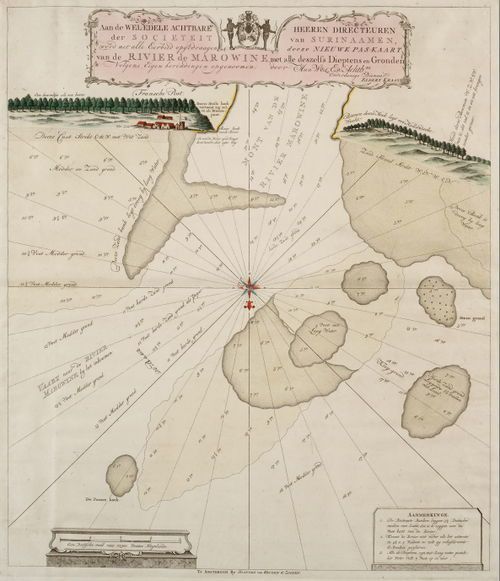
The estuary of the Maroni river, where the Leusden sunk in 1738.
When I initially read reports of the Leusden, without any geographical reference, words like "sandbank," "estuary," and "mouth" of the river seemed an indication that the ship was not extremely far away from land when it faltered. I recalled an image I’d seen of the Peter Mowell — a cargo ship that wrecked in the Bahamas (1860) carrying nearly 400 African captives who were able to swim to shore. And, I imagined that survival on the Leusden might have been entirely probable had the Africans been given the opportunity to save themselves. Although, history has long demonstrated that the humanity of Africans had no integral value to anyone involved in the enterprise of chattel slavery, if only from a capitalist point of view, I could not imagine why Captain Joachim Outjes led his crew in the destruction of their valued cargo: 664 beating hearts, from which they stood to generate an enormous profit in the wretched trade.
Given the brutal background of the ship - which sustained a deadly uprising just two voyages before this one - Dr. Balai's writings would reveal that it was fear that motivated this meditated mass murder. If left to their own devices, Stephen Moore, manager on the project, confirmed that — based on what they have seen and discovered thus far — yes, it is likely that many of the African captives would have been able to survive the wreck.

Illustration of the Peter Mowell shipwreck, 1860.
The search for the Leusden is a collaborative effort between the authorities and scientific and cultural institutions of Suriname, the Netherlands, French Guyana, and France. An outgrowth of Dr. Leo Balai's historical research, the team includes a diverse group of professionals working in various aspects of marine offshore services; technical people experienced in marine survey, archaeology, and shipwrecks; and a short list of governmental and international agencies providing support. Given the nature of the wreck, the death toll, and the anticipated presence of human remains, the search team is approaching this not only as an archaeological expedition, but as a homicide investigation. Dr. Balai describes it as an "incomparable tragedy."
Led by Dr. Balai and Professor Jerzy Gawronski, who serves as an Archaeologist for the Dutch government, and managed by Stephen Moore, Managing Director of Underwater Technical Services Ltd., Norwich, UK, the research team consists of an international group of volunteers who have been combining their resources to uncover the shipwreck mystery. Beginning in 2013, a preliminary reconnaissance test survey was conducted in the Maroni River that allowed the team to narrow the search site down to two possible locations, on either side of the river. Using divers and sound equipment (borrowed from Plymouth University), the purpose of this first survey was to gather information on the conditions in the river, to test equipment, and to assess the feasibility of mobilizing a full marine survey and eventual recovery of the wreck. It is important to note that while the Dutch had record of the Leusden and its history, the South American countries, near which the ship faltered, were completely unaware. Dr. Balai and his team also wanted to gauge the bearings of the local government, institutions and people, and found them abundantly interested in and supportive of recovering this shared heritage.
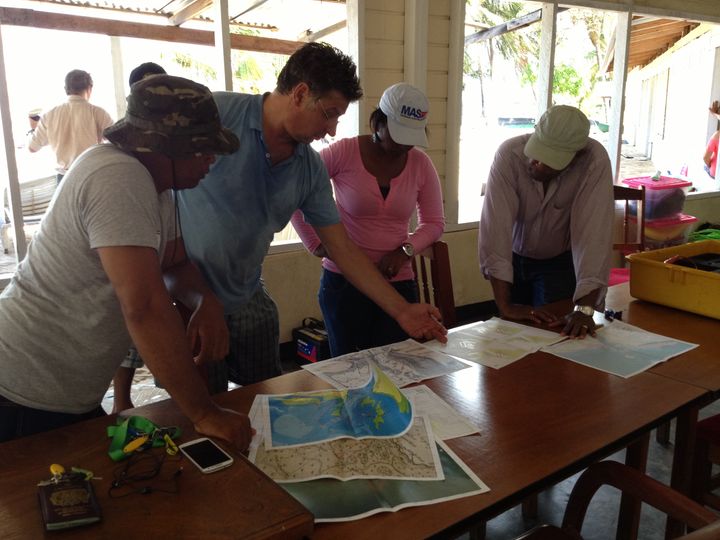
Leusden project meeting at Galibi, Suriname, 2013-14
Balai and Moore hope to travel back to Suriname and French Guyana in April to pave the way for a broader expedition in the fall of this year. For this, they are seeking to raise a total of about $100k and have been meeting with additional partners, including UNESCO. More recently, a Toronto-based film production company has expressed interest in using the Leusden research as the centerpiece of a TV project they are developing on the slave trade for major U.S. networks. Involvement in the film will also help move the project toward its goal.
Discovery of the site promises to be the second largest archaeological find in the history of the slave trade, rivaled only by the discovery of New York's Lower Manhattan African Burial Ground (1991), where the remains of 491 African men, women, and children were discovered and 20,000 are estimated to be buried over a five block radius. Still, the-nature of this scene, which has resulted in an unnatural graveyard embedded in the Atlantic Ocean, exceeds everything in its criminality.
The wreck of the Leusden is additionally symbolic of multinational world heritage. Originating in the Netherlands, the ship docked and loaded in Ghana, was destined for the slave port at Paramaribo, Suriname, and met its demise at the mouth of a river between Suriname and French Guyana. It is connected to the histories of each of these countries and the wreck site, as well as its remains, will become part of a knowledge base for a broad international public of scientists and historians interested in the slave trade. Finding the Leusden promises to yield varied archaeological data, including the construction and equipment of the ship, the daily reality of slave transport, and the material culture and physical backgrounds of the African captives. This information can add a unique dimension to the history of the international slave trade, however, the site of the Leusden is also a place of memory, and a sacred space with a spiritual value connected to the loss of 664 African lives — men, women, husbands, fathers, mothers, wives, sisters, and children. It is a place where souls of unrest may be recognized and honored, at last.
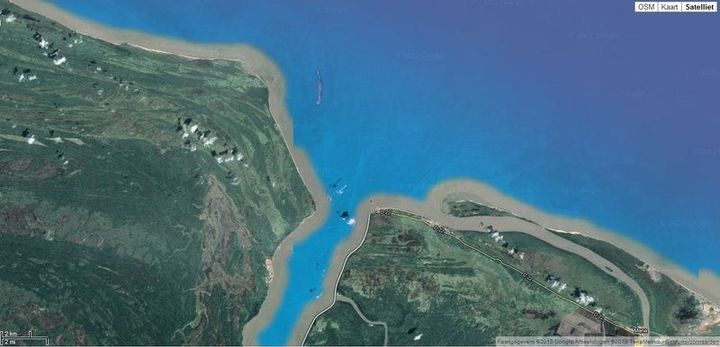
Google earth image of the Maroni river estuary, with Galibi Village on the left bank underneath the mouth of the river
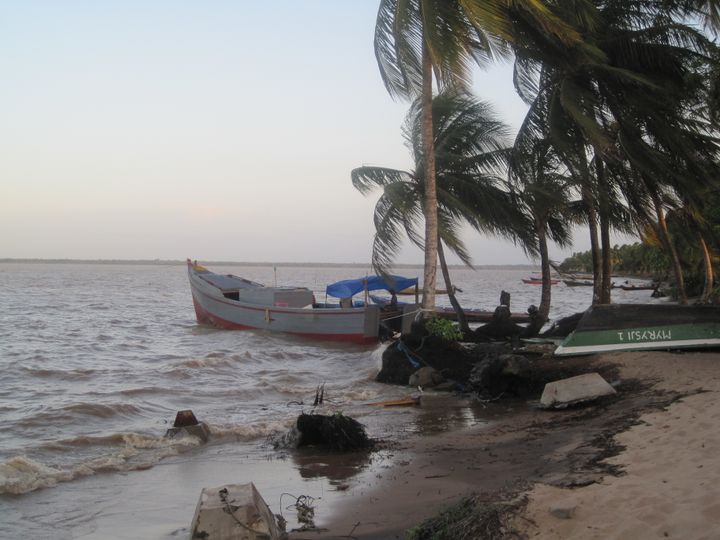
SK 1427 fishing boat from Paramaribo, used as survey vessel, anchored in front of Galibi

View of French Guyana from Galibi
Organizations involved in the search have included: Ministry of Foreign Affairs, Suriname; Maritime Authority, Suriname; Ministry of Culture, Direction des Affaires Culturels de Guyane, French Guyane; The Netherlands Cultural Heritage Agency; Ministry of Culture, Départment des Recherches Archéologiques Subaquatiques et Sous-Marines (DRASSM), France (Marseille); University of Amsterdam; Plymouth University; Underwater Technical Services, Norwich, UK; Stichting Olivier van Noort, Aamsterdam
Research has been supported by: DutchCulture; The Netherlands Cultural Heritage Agency; Embassy of the Kingdom of the Netherlands In Paramaribo, Suriname
Visit slaveshipleusden.com to follow the project.
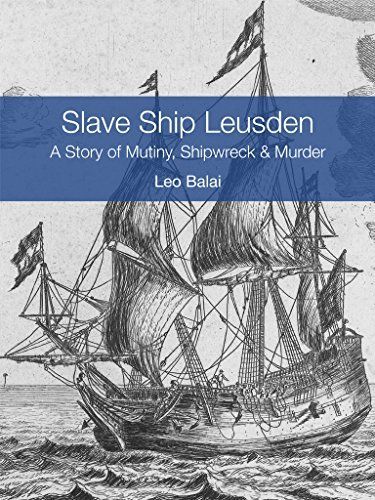
“Slave Ship Leusden”, the book, is an adaptation of Dr. Leo Balai’s scientific research into the history of the Leusden, one of the last slave ships of the West-Indian Company (WIC). Available at Amazon.com
Read The Slavery Papers I: Of Slave Ships Lost | Read The Slavery Papers II: The Story of The Leusden
